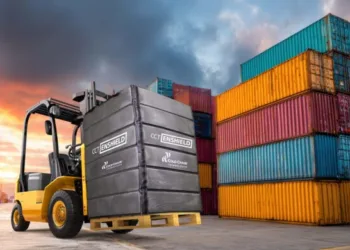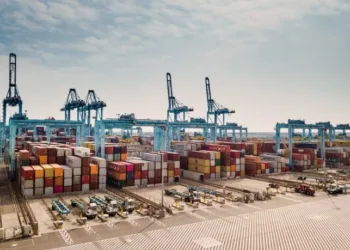In a freight market that is not offering any help to its truckload operations, 3PL RXO Inc. has found a short-term savior: its growing LTL business.
In a quarterly earnings report that on major financial numbers reflected the reality of the ongoing freight recession, RXO executives in their earnings call with analysts boasted of the big gains it is making in its push to grow LTL activities on both an outright basis and as a percentage of the company’s total operations.
RXO’s (NYSE: RXO) overall brokerage volume growth was up 1% year over year, which CEO Drew Wilkerson noted still exceeded the Cass Freight Index, which contracted more than 3% for the quarter.
But for RXO, its LTL brokerage volume was up by 45% year-on-year, and it follows a 26% growth in the first quarter.
“We continue to win in this area because we make LTL shipping easy for our customers,” Wilkerson said.
The CEO said RXO has made a push in its LTL operations by investing in “cutting edge technology that improves productivity and reduces costs for our team while giving LTL customers complete visibility.”
Wilkerson said RXO has relationships with “nearly all the LTL providers in North America.”
“Growing our LTL business is a key part of our company strategy, because it provides a stable source of EBITDA with strong margins across market cycles,” he said.
In his comments on the call, Jared Weisfeld, RXO’s chief strategy officer, said LTL activities were 32% of all brokerage volume in the second quarter. That was up 1,000 basis points from a year ago, he said, and was the highest level in RXO history.
Not surprisingly, when phone lines were open to questions from analysts, one of the first was about the ongoing trend of LTL being a growing share of the RXO business.
Wilkerson said the change grows out of “the relationships we have on the truckload side. These are customers who have been with us a really long time, and they’re large customers, and they come to us and they say, LTL is a small piece of our overall transportation spend. I’m working with a few of the national players, but I’m having to go into different platforms, and I’m having to look for claims, lost shipments, damages, all of those things.”
Familiarity with RXO platform a key plus
But Wilkerson said since these customers are familiar with RXO and in particular its online platform RXO Connect, they see that as a logical step to move some of their LTL business–which might be a small percent of their overall freight spend–onto that platform.
“They think if we can put everything on RXO Connect and now we can start capitalizing on some of the capacity from the regional players as well, this can be something that gives us better visibility,” he said.
Wilkerson also drove home the message that the latest numbers are not an aberration. “LTL is going to be part of our growth story for a long time,” he said. “We’re just getting started.
He reviewed the company’s data. LTL volume recently had been just about 10% of overall brokerage volume. It’s now more than 30%. “I want that volume to get up over 50%,” he said.
What he described as the inherent stability of LTL relative to truckload “adds to margins.” Gross profit per load, according to Wilkerson, “doesn’t have the volatility that truckload does. So it’s good stable EBITDA for us as a book of business.”
Wilkerson brought in an unusual benchmark for the LTL business: the price of a candy bar. Snickers, in particular.
The Snickers analogy
An analyst noted that despite the excitement about LTL, its gross profit per load has moved down slightly in recent months, according to a table in RXO’s presentation. The size of the gross profit per load was not disclosed, but the graphic on its movement showed LTL brokerage volume at RXO soaring and gross profit moving down slightly in the last two quarters.
“I don’t think you can walk outside of your office in New York and buy a Snickers bar for how little gross profit per load is down whenever you look at it sequentially,” Wilkerson said.
(The author of this article, not having bought a Snickers bar in New York recently despite residing a train ride away from Manhattan, is unaware of how much it costs. But you can buy a box of 40 of them on Amazon for $51.90 before any shipping or taxes. You can also do the math).
But that is a positive, Wilkerson said. “That’s the beauty of the LTL business,” he said. The RXO chart showing little change in the gross profit per load shows that “it is very, very stable on what it does.”
Some of the RXO LTL business that it has recently onboarded, Wilkerson said, has been for relatively short length of haul distances. “So that means your revenue per load comes down, and therefore the gross profit per load is a little bit lower on those, but it’s still a good margin percentage,” he said. “It’s highly automated and accretive.”
Among other key points made on the call:
–With the completion of merging the technologies of both RXO and the legacy Coyote Logistics brokerage–acquired by RXO in the third quarter of last year–efficiencies are starting to develop in many areas. Weisfeld said the company’s “buy rate”–what it pays to secure capacity–has improved by about 30 to 50 basis points “in a period where rates were inflationary. So that yield is a significant cost avoidance.”
–Truckload brokerage volume declined 12% year on year, Wilkerson said. But he said truckload gross margin was 14.4% in the quarter, which was above the midpoint of the company’s projections. Gross profit per load in truckload was up 7% sequentially, which Wilkerson said was the strongest sequential increase at RXO in three years. It is expected to rise in the third quarter as well. Technology enhancements and the productivity gains that go along with that are the primary drivers of that improvement, he added.
Weisfeld said a slowdown in automotive activity accounted for about 25% of the decline in truckload brokerage volume. “RXO is uniquely exposed to the current automotive headwinds,” he said.
–The split between contract and spot business at RXO was 73% for contract and 27% for spot. “We continue to operate in a prolonged soft freight environment with minimal spot opportunities,” Weisfeld said.
More articles by John Kingston
In brief comments, Trimble CEO introduces new product for matching capacity with shippers
At C.H. Robinson, improved profitability, productivity and a lot fewer workers
Each driver’s payout in Lytx Illinois biometrics case will be between about $650 and $850
The post LTL proving to be big growth engine at RXO appeared first on FreightWaves.






















